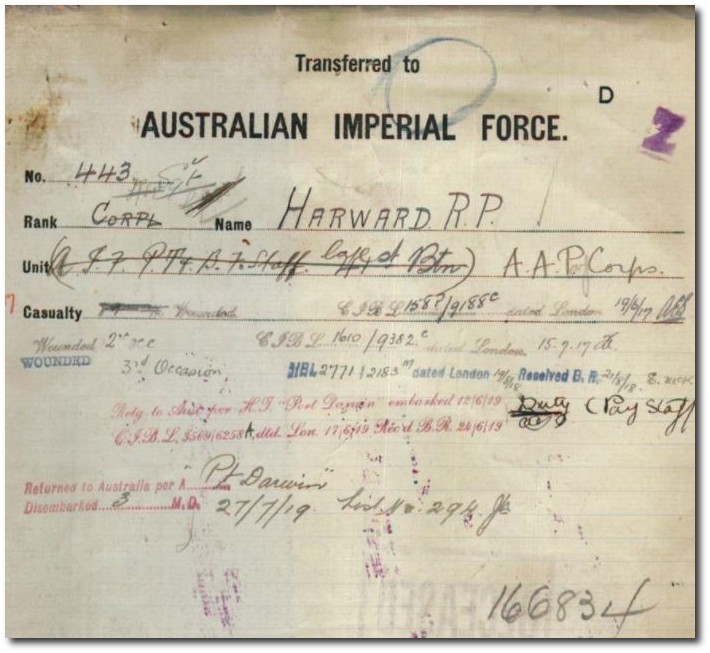
Extract from AIF service record for Percy Harward, page 32
Indigenous Australian, Robert 'Percy' HARWARD, 41st Infantry Battalion
Percy Harward was born on North Stradbroke Island in 1895 to Walter Harward and Charlotte (Lotti, nee Campbell). One of eight children, he and his brother Arthur Walter Harward both served in the First World War, his sister Silvia served in the Second World War.
Like his brother Arthur, he attended Myora Aboriginal School & Dunwich State School, and was not quite 20 years of age when he volunteered to serve with the first AIF in November 1915.
Assigned to 'B Company' 41st Infantry Battalion, he trained at Bell's Paddock, Enoggera before sailing for overseas aboard HMT Demosthenes in May 1916. After further training in England he arrived in France in November 1916 and was shortly thereafter taken ill with mumps.
After three weeks in hospital at St Omer, he rejoined his unit in the field. He was briefly assigned to 2nd Australian Tunnelling Company but returned to the 41st Battalion in February 1917.
In June 1917 the 41st Battalion was serving in the front lines near St Ives; on the 9th June, Percy Harward was wounded in the field, gassed, and was hospitalised for several days before being returned to his unit.
Three weeks later at Messines, he was again wounded, with a shrapnel hit to his shoulder. Percy was evacuated from the front lines to hospital for treatment and returned to his Battalion four weeks later.
Early in 1918 he was selected to attend several training schools in England and had by this time been promoted to Sergeant. When he returned to his Battalion they were still very much in the front line, and Percy was wounded for the third time, in the right leg in August 1918.
By the end of the war Percy had been hospitalised 5 times. Before returning to Australia he was attached for duty with the Australian Army Pay Corps for several months before finally returning to Australia in September 1919.
Read more ...
- North Stradbroke Island’s First World War Soldiers and the Homefront
- Myora Aboriginal School Admission Register 1893-1941
- Service record: HARWARD, Robert Percy
- Embarkation roll: 41st Infantry Battalion
- Queensland’s Indigenous Servicemen [oral history]
The information in this blog post has been researched by State Library staff and volunteers, it is based on available information at this time. If you have more information that you would like to share or further research uncovers new findings, this post will be updated.
Comments
Your email address will not be published.
We welcome relevant, respectful comments.